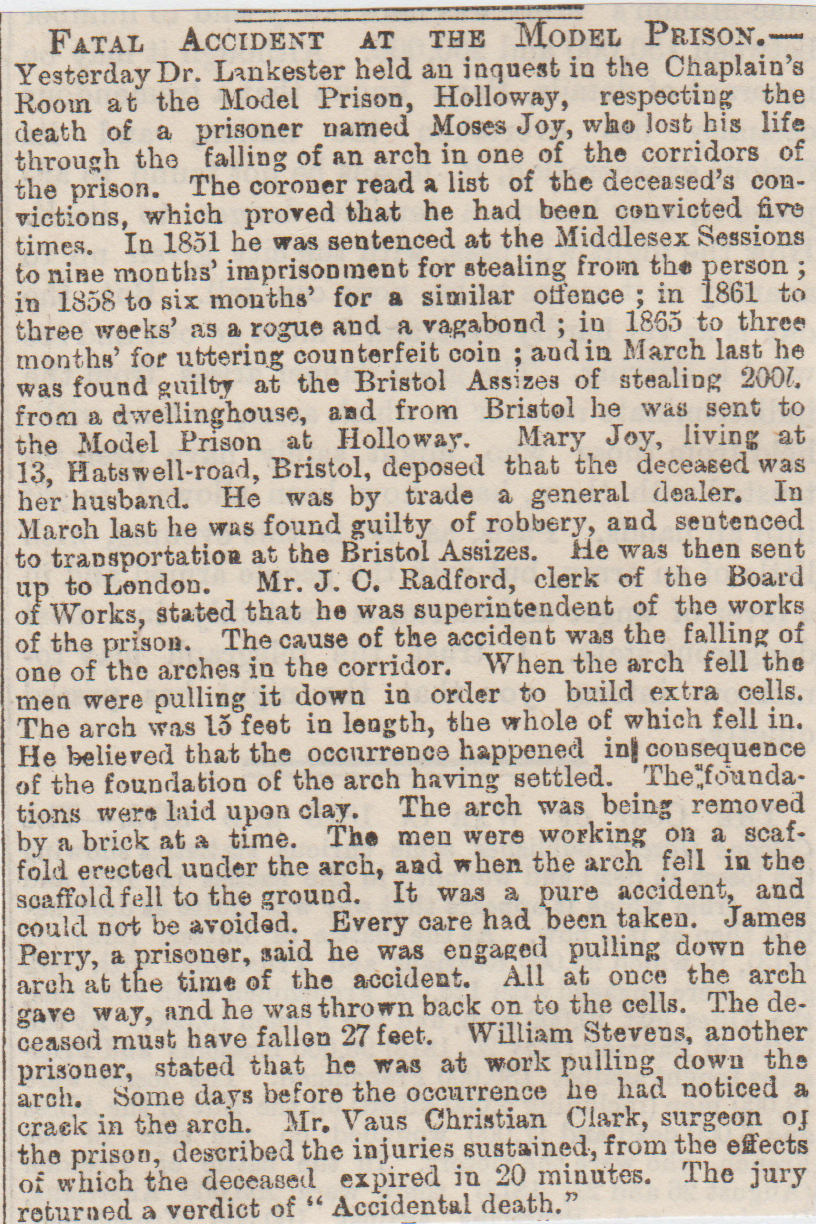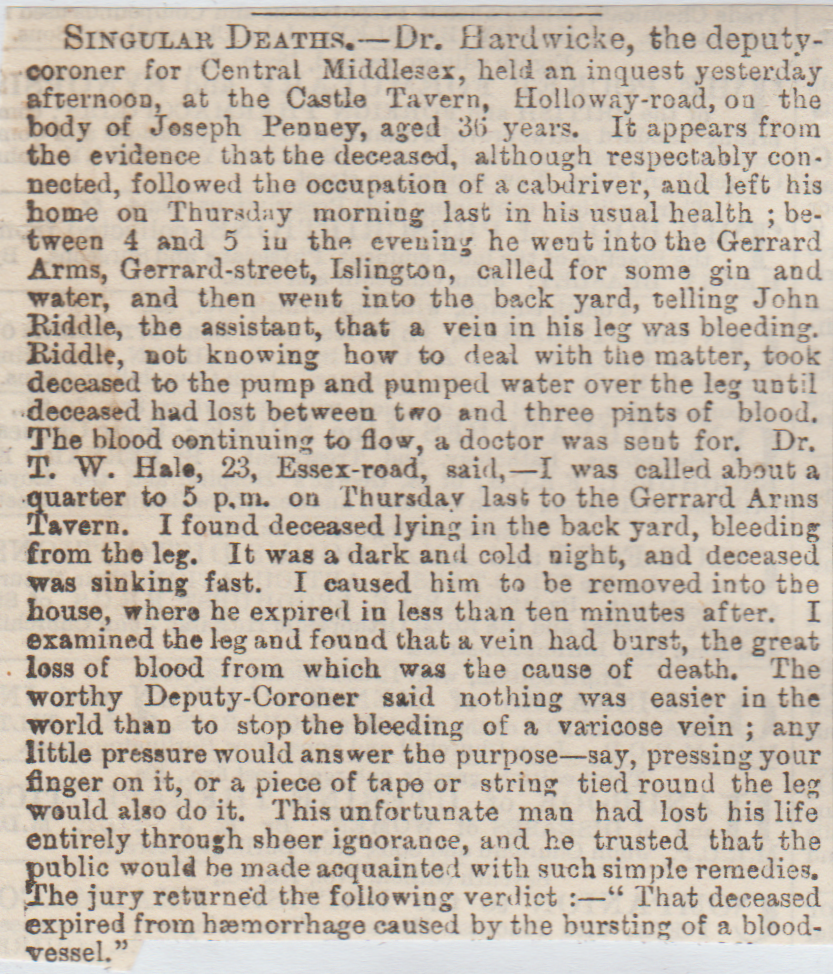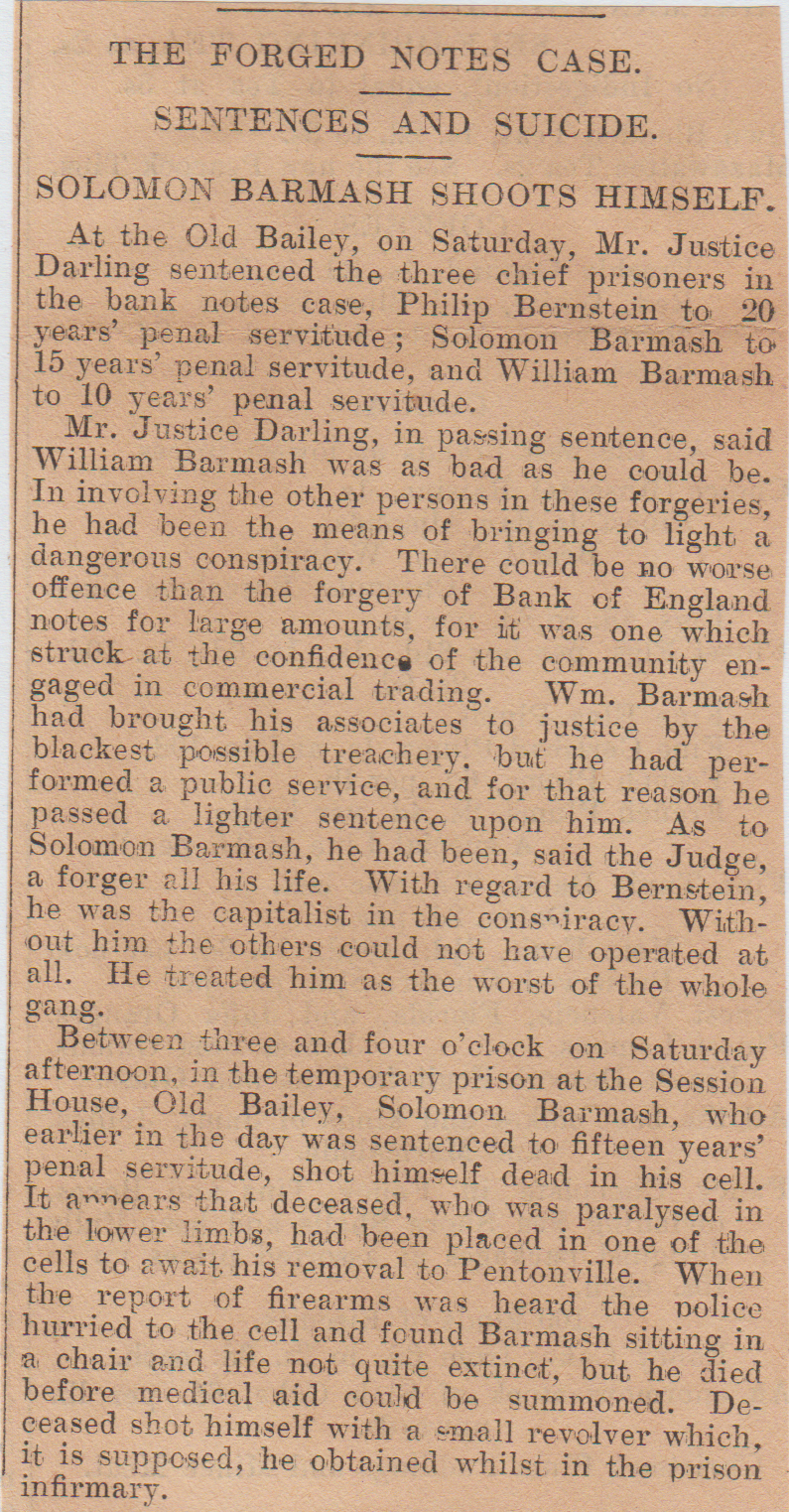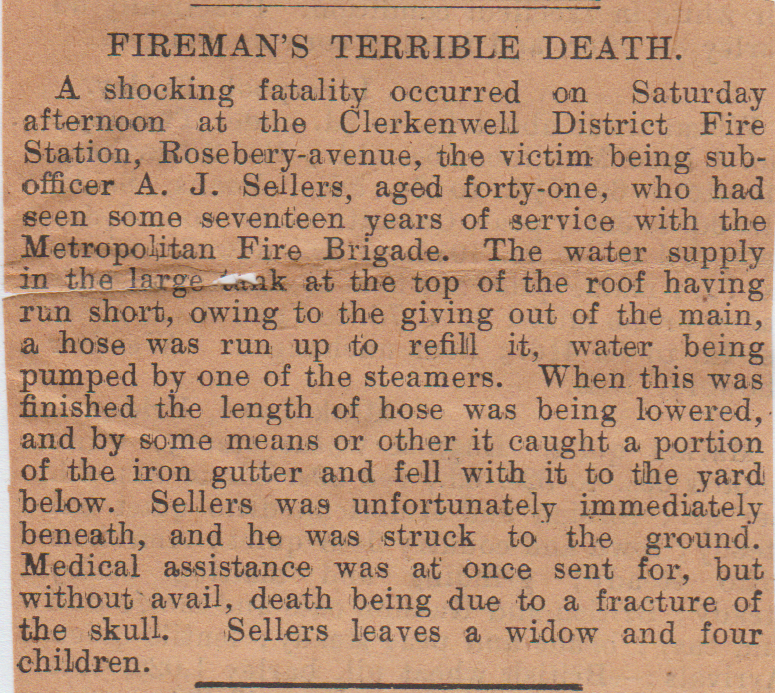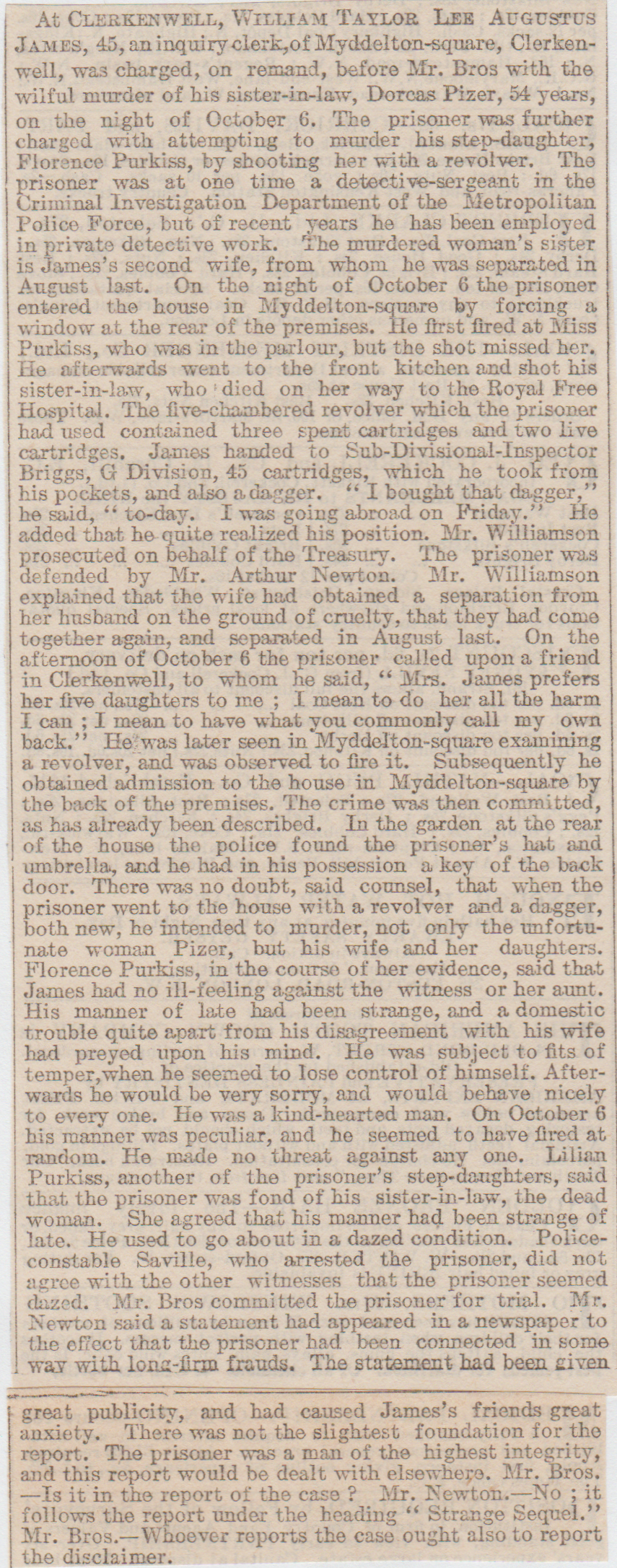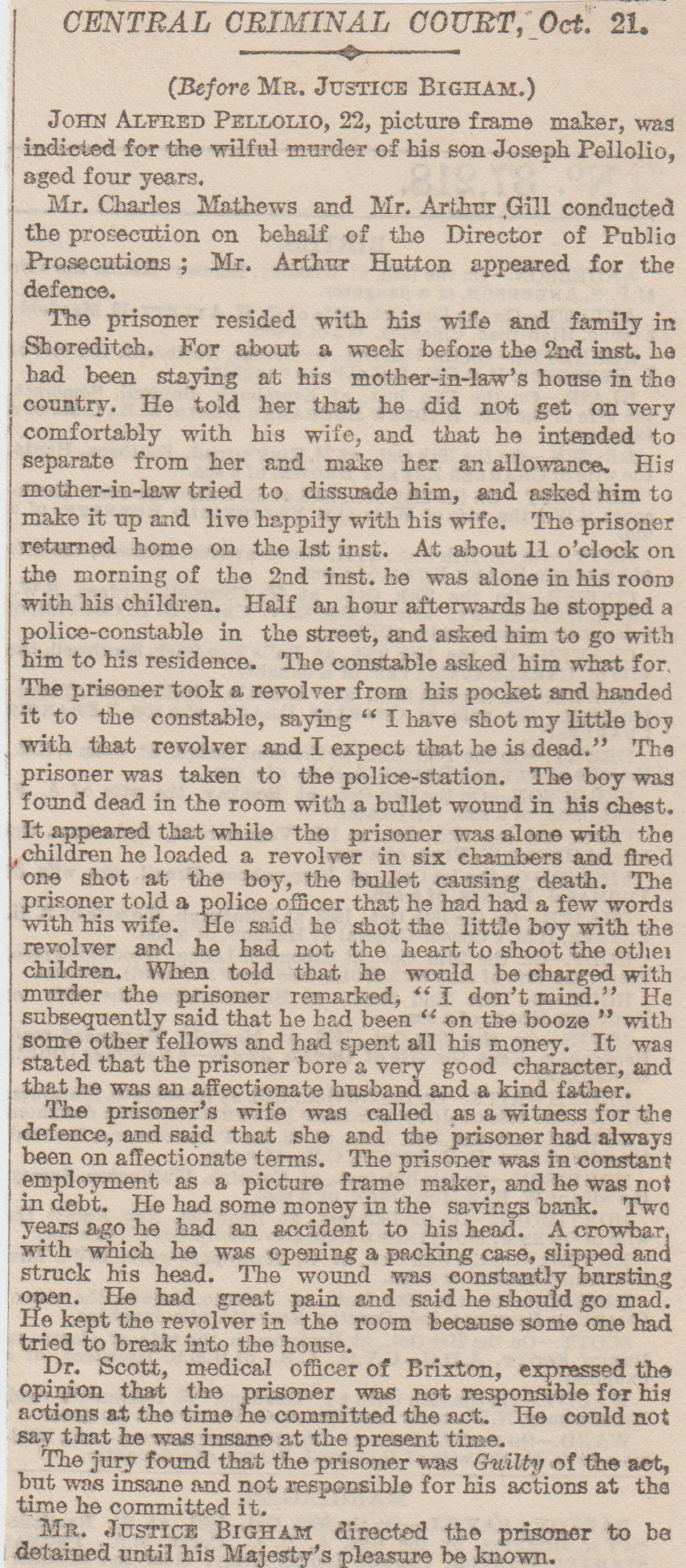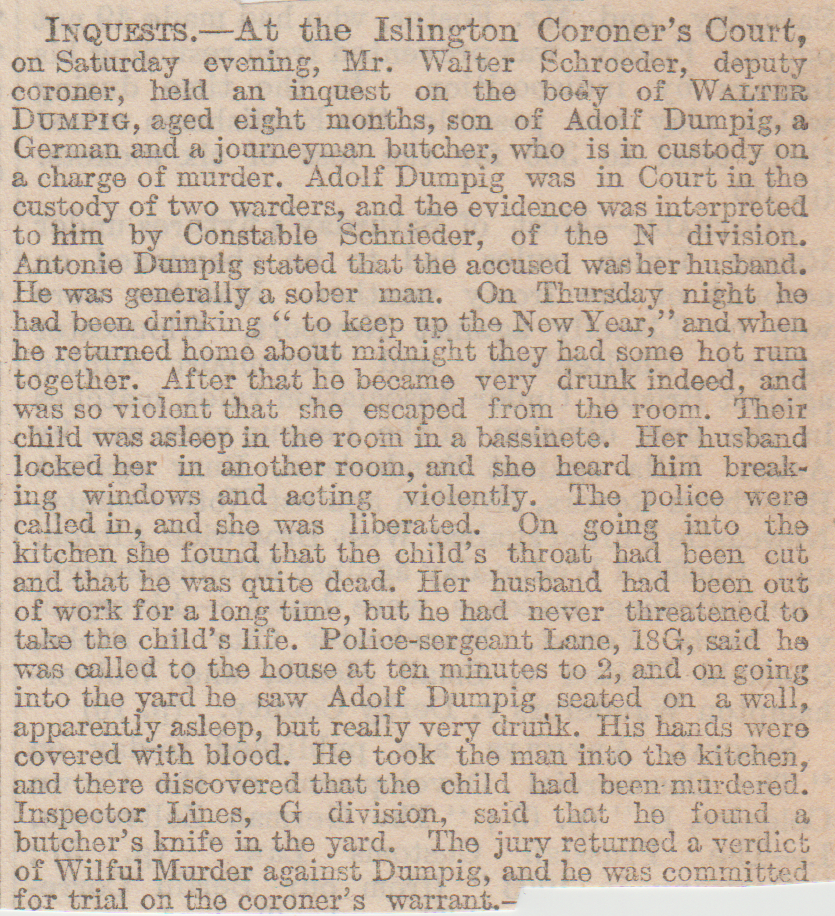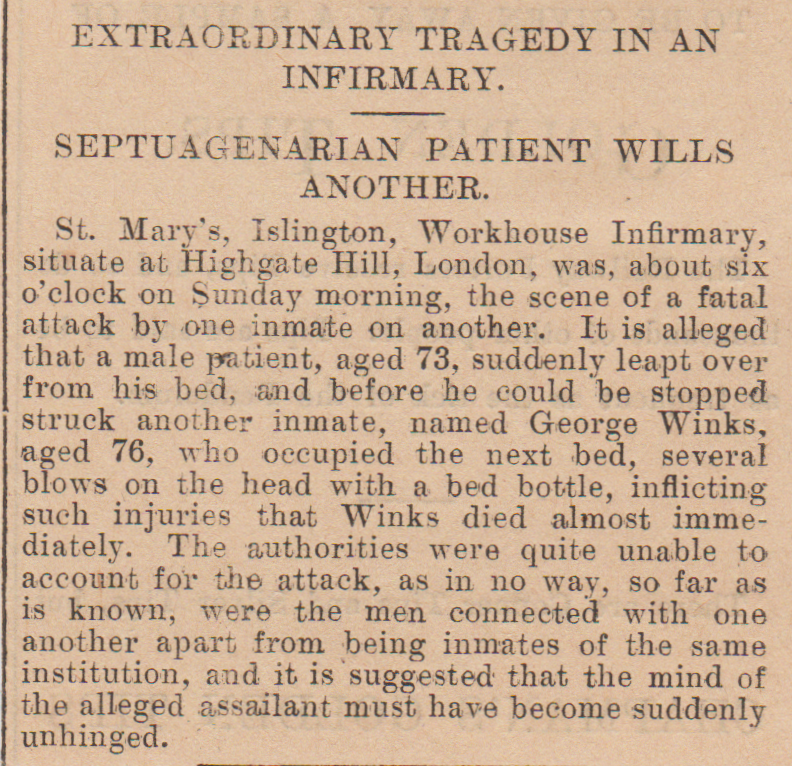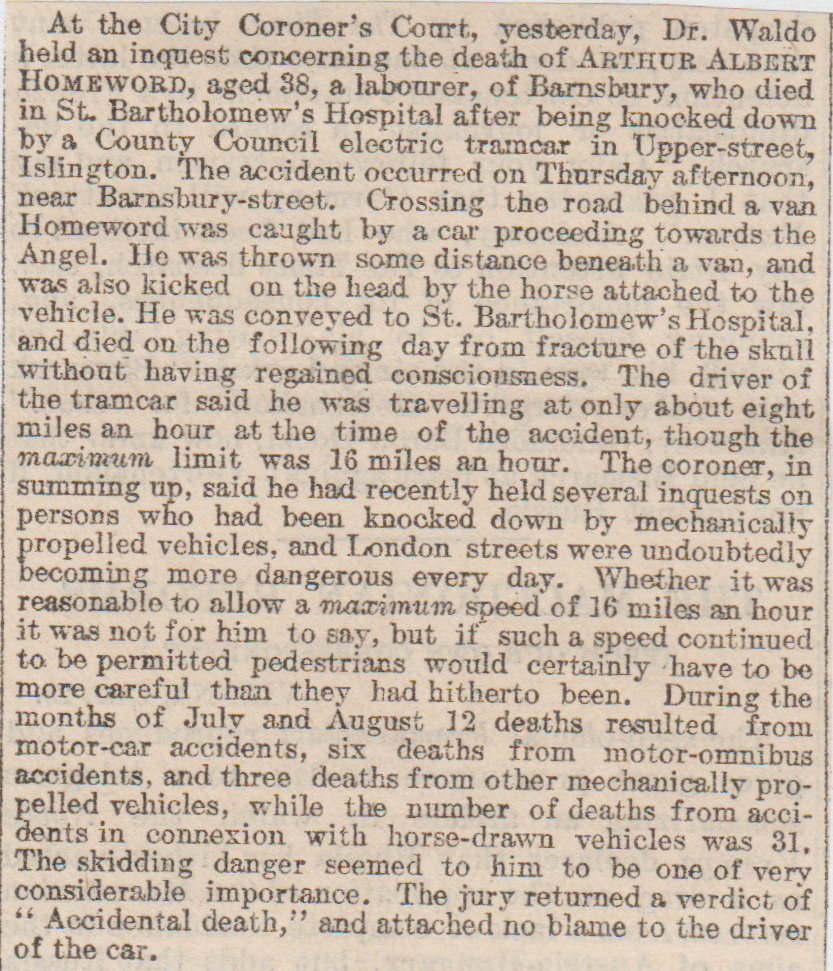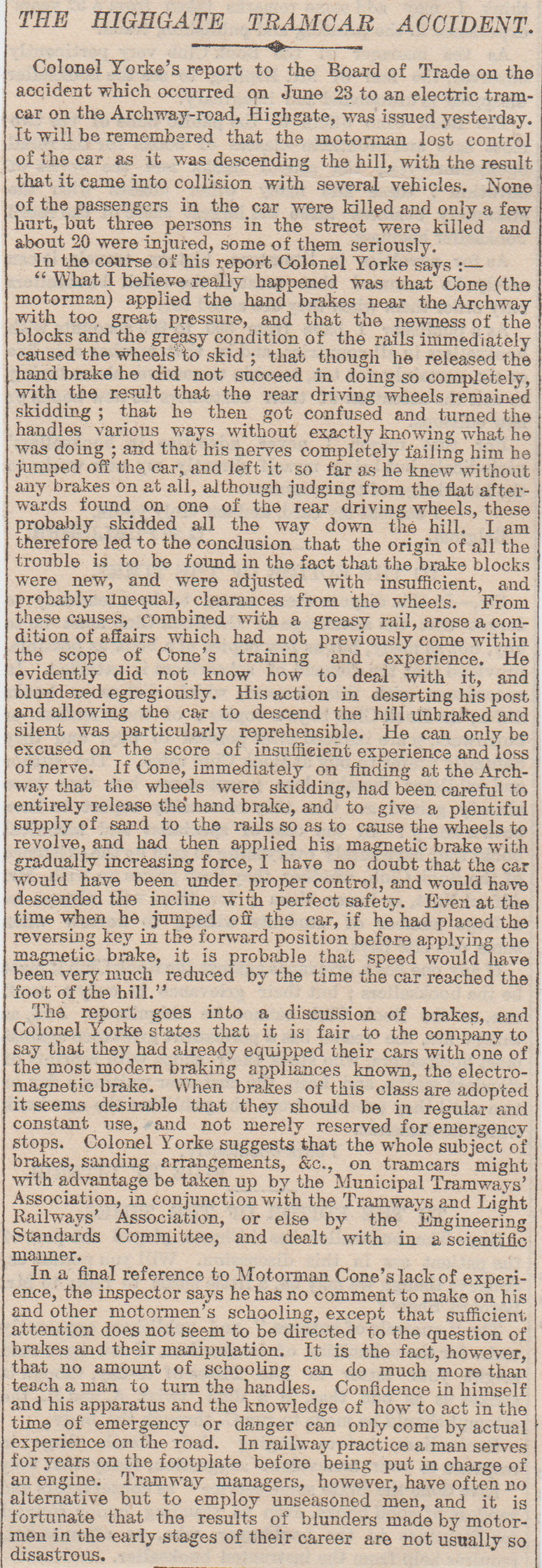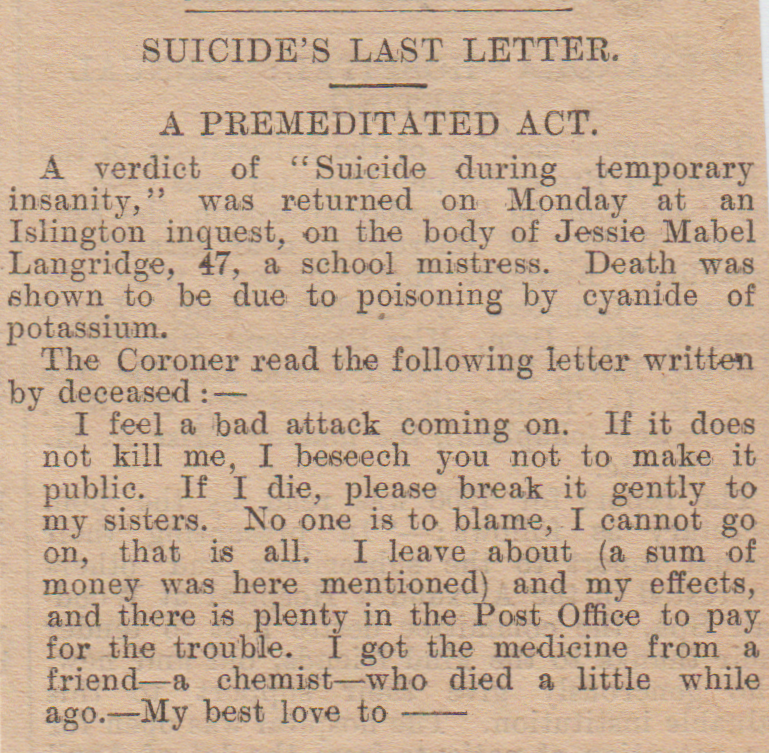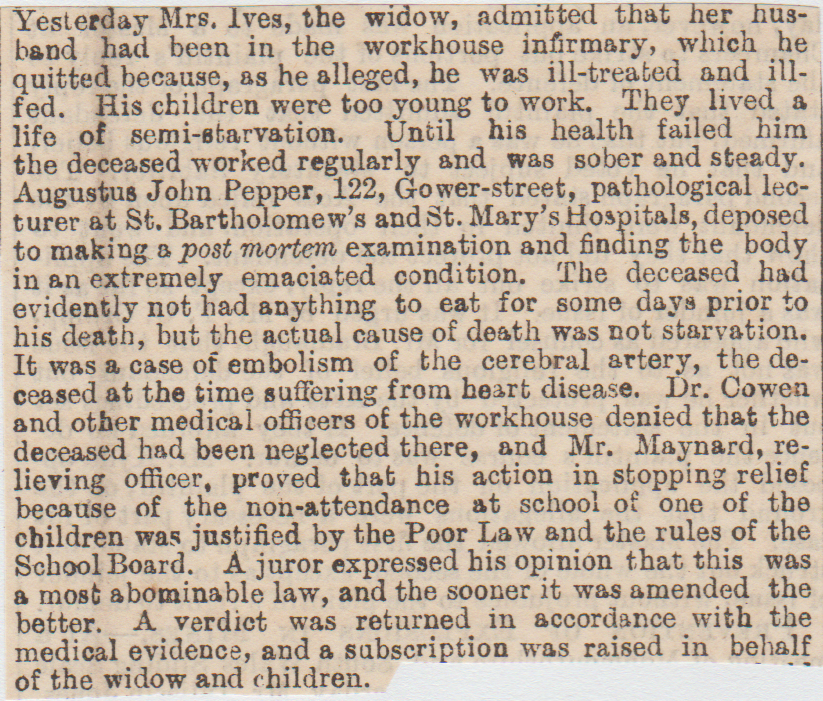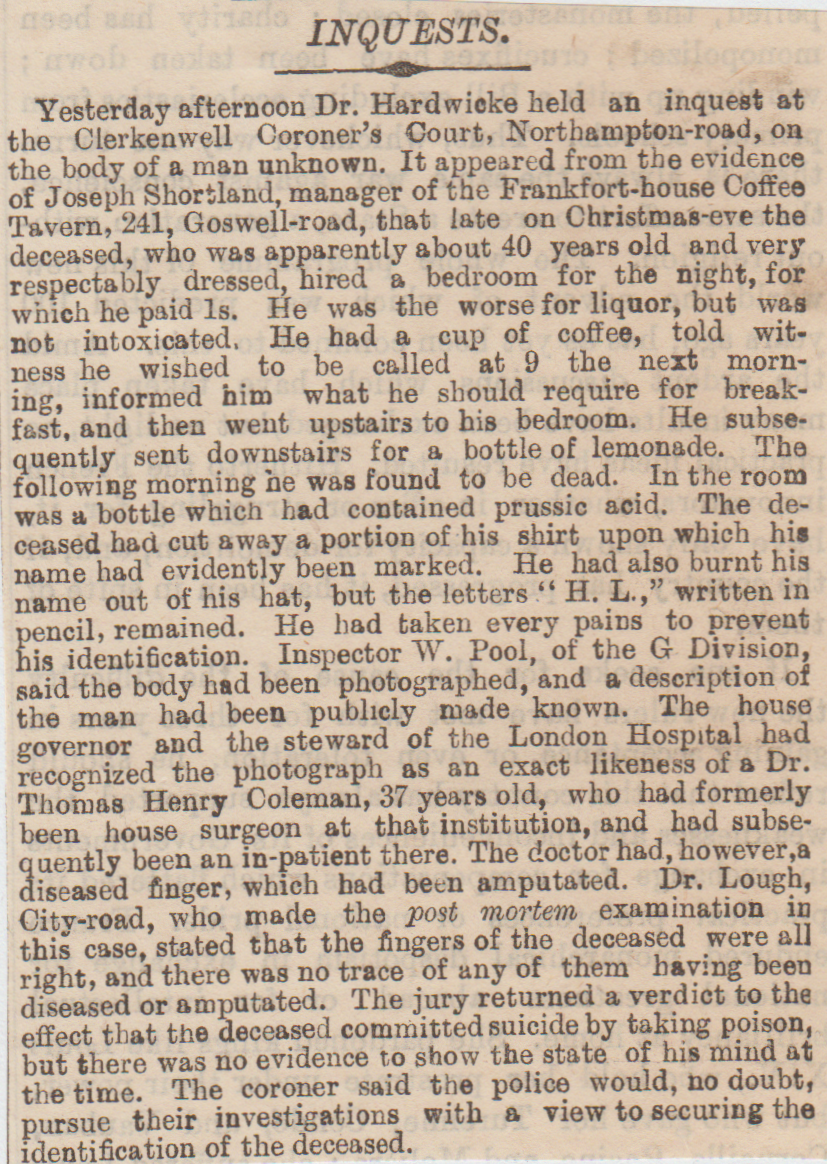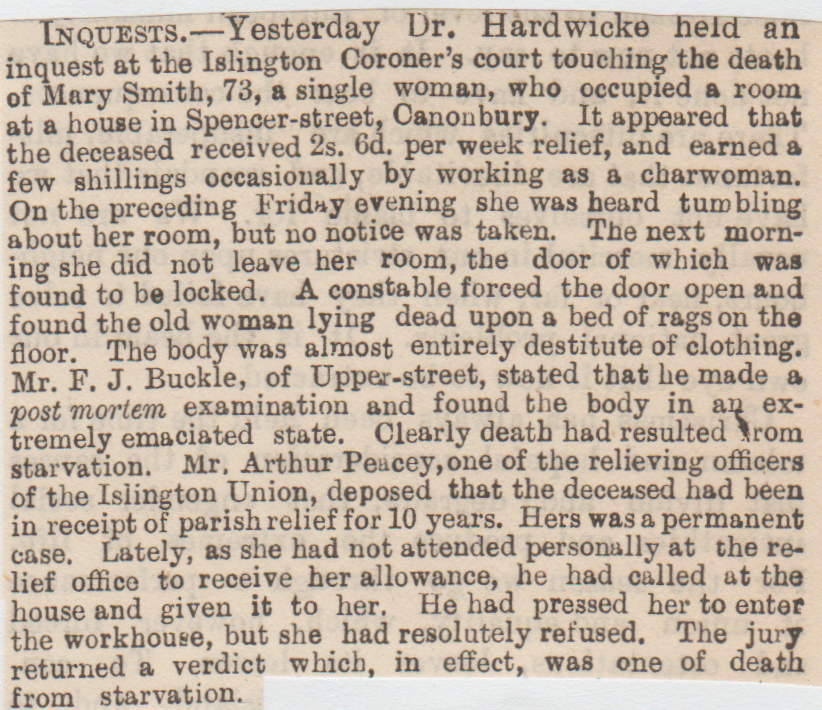1/ Highbury Church Suicide, Islington, May 1896
Christ Church (on Highbury Grove) in Highbury, saw a suicide within its doors in 1896. The verger opened the doors and found an adult male swinging from a rope as soon as he entered. The suicide was that of a 42-year-old Brummie, by the name of Herbert Napper. (Why in a church?)
2/ Dead Baby Found in Clerkenwell Church. September 1896
Another body in a church, this time in Clerkenwell. The Church of St.Mark’s is still there in Myddelton Square and in 1896 someone decided to drop off a dead new-born there. It was a girl wrapped in calico, who had a piece of cloth in her mouth. Whether this was to keep it quiet and accidentally killed her, is not known. Police were summoned and Dr Miller of Percy Circus was due to do a post-mortem on the infant.
3/ Highgate Archway (Suicides Bridge). August 1898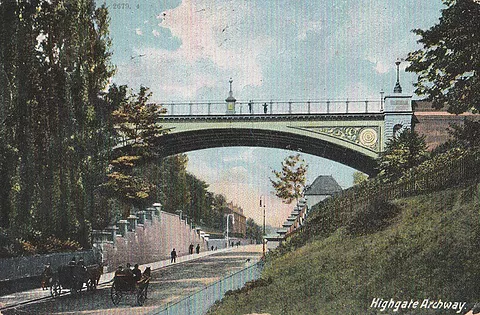
Now under reconstruction, the Archway has for quite a number of years, been a very common place for suicides. There was no real barricade or railing to prevent the act and let them dive onto the road under it, a drop of sixty feet or more. Half the bridge was in one parish and the half was in another, so you could decide who should bury you, if unclaimed. One of the parishes did put up a railing, but they just moved a few yards and leapt off there.
4/ Highgate Archway, July 1884 (Bridge Suicide)
A man was seen to climb up the parapet on the bridge in Hornsey Lane, Highgate, and throw himself off onto the road below. A P.C. from Y Division, plus a crowd of rubber-neckers, found him unconscious. By the time Dr Jones got there, he was dead, not surprising because of his fractured skull and other injuries. His body was taken to Hornsey Mortuary to await identification. He was five feet eight inches tall in his mid-thirties, fair hair, light moustache, scar on lower lip and chin, brown tweed suit on, blue checked shirt, black felt hat, and looked like a labourer. Unknown?
5/ The Flask Public House, Highgate, November 1899 (Photo is from the 1920’s)
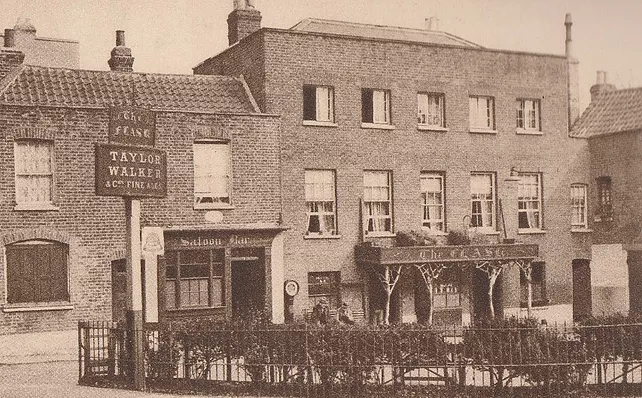
The above picture comes from the “Wonderful London” magazine and holds a special place in my life because I used to work here in the late 1980s. All I remember was Ray Davies from The Kinks lived next door to us, and Sting lived across the road. The other thing I was told about was the Dick Turpin legend and how he stopped off here and about the secret passages underneath it. This is the story from November 1899-
Thomas Henry Blake from Holloway was missed from a pack of runners in South Grove, Highgate. He was discovered in a sink-hole, about six feet wide and fifteen feet deep, and pulled out and taken to the police station, then allowed home. The subsidence was due to an underground passage that had collapsed and on looking for the course of this passage, another was found. The main tunnel led to The Flask in South Grove, and legend has it, that Dick Turpin used this place as a stop off. The pub has several trap-doors in the cellars and were said to be used as an escape route in times of danger.
Highgate Wood Suicides
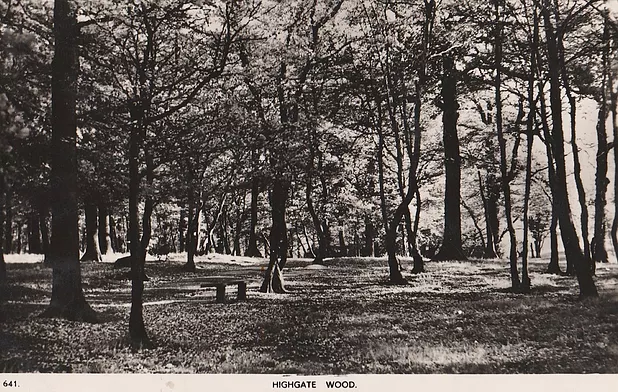
6/ January 1890
A man was ambling through the woods when he stumbled on the body of a male, covered by fallen leaves. He had a cup and bottle by his side and had taken some laudanum. Police removed him to the local hospital, but he died before he arrived there. Identification of the man found him to be a tram conductor from Holloway named Dalziel, and the tram tickets in his pocket proved that he came from work, straight down to the woods to kill himself. One or two letters on his person reveal the reason for this rash act, to be one of jealousy of his wife.
7/ November 1874 (Vicar Suicide)
In one of the smaller woods of Highgate Woods, one called Gravel Pit Wood which is near the Muswell Hill Road, the hanging body of a clergyman named Rev. Pix, was found on an oak tree. The police surgeon estimated he had been there for a week and the worrying thing is that this is becoming a suicide hotspot, as this is the third in as many years in Highgate Woods. Pix was from Dorset and he was staying at Kings Cross with his keeper, as he considered to be insane. He escaped and ended up here.
8/ June 1872
William Riddnell found the body of a man who had slit his own throat in Highgate Woods. The John Doe had a pen-knife in his hand and was drenched in blood. A half pint bottle of brandy was beside him. He was about sixty and about five feet six inches tall, dark hair, grey tinges, tattoos on arms and chest, (ship, female, anchor, shield, moon and stars, spears, and a crown), dark grey suit, and a plaid scarf.
9/ Camden Passage Murder, Islington, July 1890
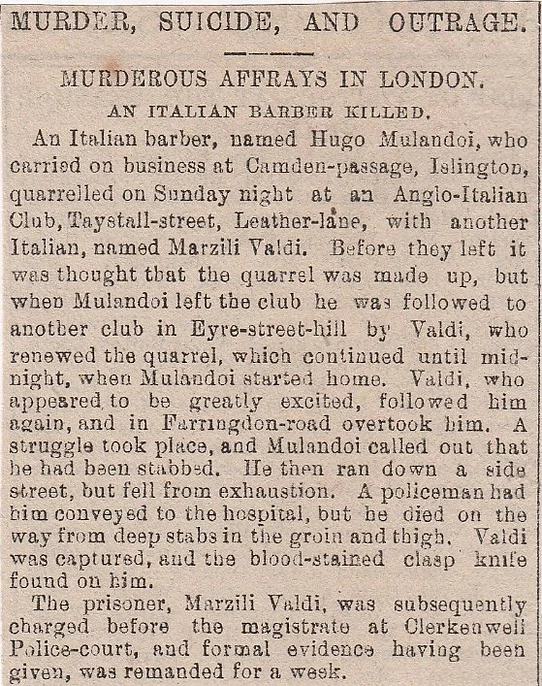
10/ Highgate Cemetery (Childs Body Found) January 1845
Near Highgate Cemetery in a tree trunk, a child’s body was found by a passerby. The corpse itself is somewhat decomposed, but the post-mortem revealed bruising on the head, plus other marks of violence on its body. (Was it identified?)
11/ Highgate Cemetery Fatality, September 1904
When I lived at the Flask, I would regularly visit the Cemetery. It is a tourist attraction in itself and some weird things have happened here. It was the scene of satanic worship in the sixties and seventies when the council let it go to rack and ruin, and if I remember correctly, some vampire sightings. This is just the tale of Mrs Jewel, a 54-year-old wife of a commercial traveller, who went to see her son’s grave and put some flowers on it, when she keeled over on his grave, after having a massive heart attack.
12/ Highgate Cemetery Suicide, December 1856
A labourer named Collins was stacking wood at Highgate Cemetery near Swains Lane when he heard the sound of a gunshot. He ignored it, as it was not unusual to hear guns going off in the evening, poachers being rife in the area, and when the bell tolled to leave the grounds he walked to the gates and saw the body of a man with half his head blown away. He ran to Mr Broadbent’s house (the superintendent), and they found the well-dressed man laid on the ground. The pistol he held had no barrel, as the explosion had blown it off and was some distance away from him. Police were summoned and they found a few clues as to his identity. He had a serpent ring on, his linen had the name “Henri Feuhonlet” on it and two letters, one to Miss Partridge and the other to his parents. That mentioned about his love worries and ended “I can write no more”. He was in his mid-twenties and was of foreign appearance. (Was it Henri Feuhonlet?)
13/ Highgate Cemetery Suicide, July 1900
Christian Rommeli shot himself in Highgate Cemetery due to fretting about religious matters and the sect he belonged to. The 30-year-old German, who lived at No 7, Lady Margaret Road had a hairdressers shop and was a member of the Latter House of Israel. They had to let their hair grow long and also their facial hair. Rommeli wore a hat to hide his long locks, and because of the hot weather, he had trimmed his beard off. These actions seemed to have worried him immensely. This sect had built a tower at Chatham, then their leader died and they seemed to scatter. Today we’d call this a cult.
14/ Caledonian Road, Islington, August 18th, 1885 (Attempted Murder)
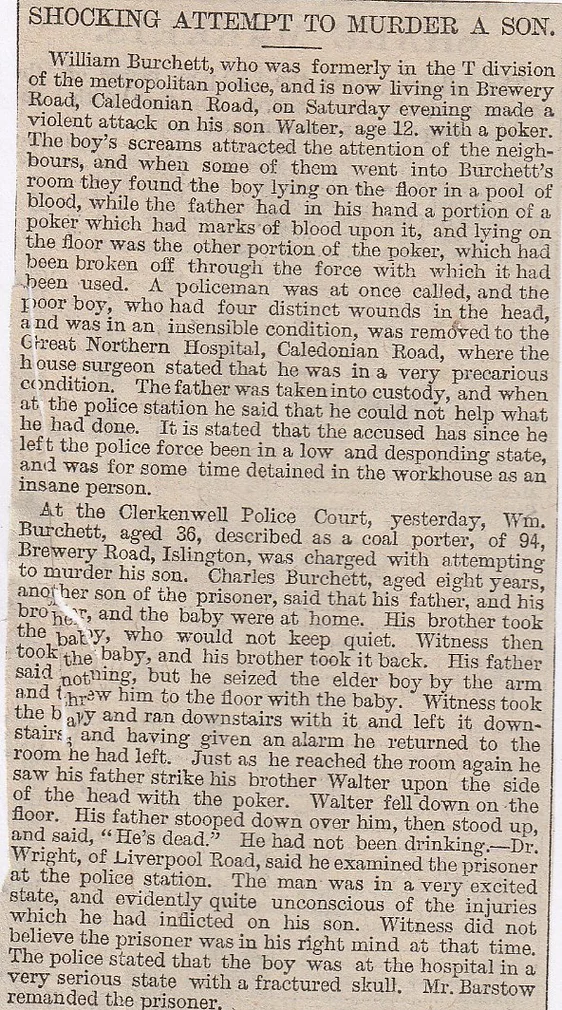
Caledonian Road, Islington, August 19th, 1885
Inquiries made at the Great Northern Central Hospital yesterday show that the lad Walter Birchill, who was admitted into that institution on Saturday evening suffering from four severe scalp wounds, which it is alleged had been inflicted by his father, is progressing favourably.
15/ Holloway Gaol Suicide, September 1857
Career criminal George Wardley aged twenty had been in and out of prison most of his teenage years and had just been given another stint in Holloway Gaol for three months. He couldn’t stand it any longer and jumped over the railings on the top landing in B Corridor. He fell headfirst upon the stone floor. He hung on to life for an hour or so then died from his injuries.
16/ St Lukes Gunpowder Suicide, March 1893
Annie Wright, thirty-eight-years of age and living at 106, Central Street, St Luke’s, liked a tipple and had promised to give up the drink many a time. She failed time and time again, so she wanted to commit suicide and end the pain and suffering. Catherine Pearson, a landlady of a public house heard a muffled bang and then someone moaning. She found Wright writhing about on the floor with blood coming from her mouth. She mumbled “I bought some gunpowder, placed it in my mouth, and set it on fire. I want to die”.
She died later on, and it was noticed that the roof of the mouth and throat, and her tongue suffered major damage.
17/ Archway Road, Highgate, November 1894
P.C. Dailey had been called to St Augustines Villa’s, Archway Road in Highgate and was told that the tenant, William Robert Walker had killed himself. The daughter took him upstairs and discovered the body in his bedroom, lying on the floor with a double-barrelled shotgun next to him. His head was entirely blown away by the shots.
18/ Royal Free Hospital Death, June 1899 (Seriously: Two Doctors called Pegg and Legg?)
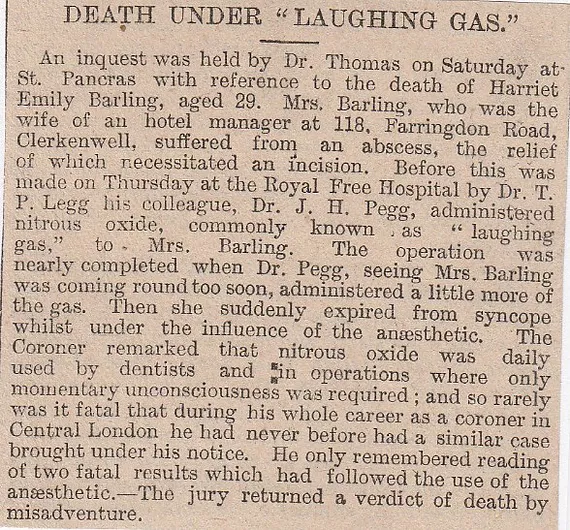
19/ Bencher’s Hotel, Finsbury, May 1899
Early yesterday morning a fire broke out at Bencher’s Hotel, Finsbury. The outbreak itself was not a serious one, but one of the inmates, Stanley Hunt aged forty-five, took a flying leap from the third-floor window and fell sixty feet upon the pavement below. The bystanders thought he was killed, but he was able to rise from the ground and walk some distance. It was evident, however, that he had suffered internal injuries and he was taken to the hospital. (Did he live?)
20/ Liverpool Road, Islington, September 1884
An elderly woman named Catherine Greenwood, along with her three brothers lived in rooms at a lodging house. She was seen to climb the balcony several floors up and plummet the seventy feet onto the road. The doctor pronounced her dead at the scene. One of the three brother’s had died last week and this preyed upon her mind, and this caused her to jump to her death.
21/ Junction Road Tram Death, Upper Holloway, September 1904
The tragic death of an eleven-year-old girl occurred at Upper Holloway. Beatrice Canepe was on an errand to get some beer for her father when she ran into some horses pulling a tramcar at Junction Road. She was wedged between the brake-block and the back wheel and it took half an hour to get her out. The guard at the front of the tram, meant to prevent such accidents, was raised up slightly, as the tram was going uphill and the passengers were all sat at the rear of the carriage. “Accidental Death”.
22/ Farringdon Street Station Fatality, January 1885
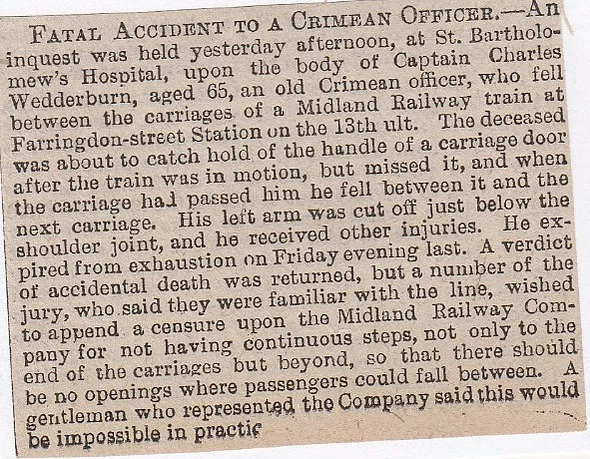
23/ Essex Road, Islington, February 1895 (Miser Dies of Starvation)
An old man name James McDougal, who kept a little tobacconists shop in Essex Road, Islington, was found dead on Monday. He lived by himself and when discovered, his room was in a filthy condition. It is said that several canisters of sovereigns were discovered but not an atom of food. Death is supposed to have been caused by starvation, yet McDougal is supposed to have died worth at least £30,000, with him being the owner of freehold property in the neighbourhood of Islington.
24/ House of Detention Suicide, Clerkenwell, July 1859
A negro named John Bardoe had a history of violent crime and misdemeanours. He had stabbed five men in his criminal past and when detained again, in the House of Detention at Clerkenwell, he strangled himself in his cell. He was inside for attacking and cutting up four men at the Strangers Home on West India Dock Road. He was locked up and checked in at around two in the morning, but they got no reply from him. The warden opened the door and saw him sat there with some torn up clothing around his neck, totally lifeless.
25/ Pentonville Model Prison Suicide, May 1885
An inquest was held at Pentonville Model Prison yesterday on the body of William Moore aged forty-seven, a prisoner who had been sentenced at Lewes Assizes on the 15th ult., to six years penal servitude for feloniously wounding his wife. On Wednesday morning he threw himself from the top landing to the gaol staircase, falling thirty-five feet. He was killed instantaneously. A verdict of suicide whilst temporarily insane was returned.
26/ No.96, Central Street, Old Street, Clerkenwell, March 1898 (Fatal Shooting)

27/ No.43, Holmsdale Road Suicide, Highgate, October 1889
Highgate police were called to 43, Holmsdale Road, by the housekeeper, who had found her master hanging in his bedroom. The deceased was Mr Arthur Richardson who was deaf-mute. She found him hanging from the bedpost. She went to Mr Brooks across the road and he helped her cut him down. Why he did this is unknown, because he had money and had just returned from the Paris Exhibition and had seemed in very good spirits.
28/ Islington Double Suicide, November 1875
Thomas Lewis, a jeweller and his missus, Jessie, were found by the lodger, after a strange suicide pact between the two of them. Jessie Lewis was hanging from the bannister and Thomas had suffocated himself with the fumes from charcoal. A note was found near the bodies, written by Jessie it said: “It is my particular wish that it should be known that I am in the last stage of consumption. It is my particular wish to die in the way I have chosen- Jessie”. The lodgers said he had behaving weirdly recently and that his wife kept mentioning how tired of life she was.
29/ Highbury, April 1885
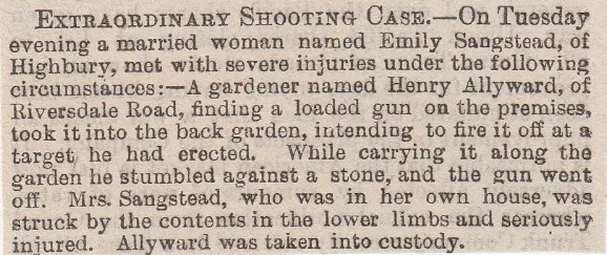
30/ Goswell Road Parcel Office, January 1883 (Body in a Box)
On the 11th December 1882, an ordinary looking box about two feet long and eighteen inches wide was passed around various offices and shops, then finally forwarded to Goswell Road, then to be sent to its final destination of:
“Miss Green, No 24, Abbey Road, St John’s Wood, N.W.” The delivery driver couldn’t find Miss Green, so took it back to the office where it stayed until a few days later. The usual story of a foul stench emanating from the package and when opened it was found to contain a dead body of a little girl. It was badly decomposed and was taken to the mortuary. A police surgeon declared it to be the body of a thirteen or fourteen-year-old girl, she was four feet tall, good-looking and fair-haired, but she rather thin. The girl resembles a girl that disappeared from West Ham some time ago.
31/ Holloway Railway Station Death, December 1900
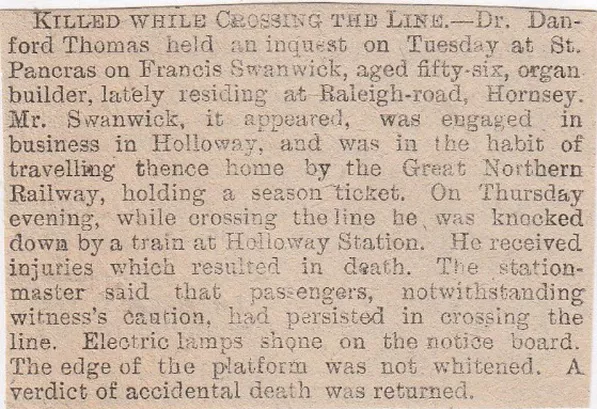
32/ Colebrook Terrace, Islington November 1851 (Self Mutilation and Burning)
Mrs Dalrymple of 4, Colebrook Terrace in Islington, employed twenty-four-year-old Mary Edwards as a housemaid, but of late she had become down in the dumps and miserable. When questioned about her demeanour, she said “I am a bad girl, and have offended God”, then would rant and rave about religious matters. When she was on her own she would recite passages from the Bible. One day Mrs Dalrymple could smell burning coming from the kitchen, so she ran to see what it was, and saw Mary stood at the fireplace with her right hand having been amputated and then thrown on the fire. It was this that Mrs Dalrymple could smell. She had the remaining stump also in the flames and showed not the slightest ounce of pain. Edwards was dragged away and asked why she did this, she just mumbled some words then passed out. She is at St Bartholomew’s hospital with little chance of recovering.
33/ Clerkenwell Murder, March 1885
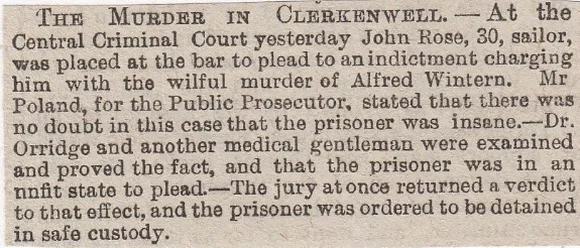
34/ Bishopswood Road, Highgate, December 1898 (Dead Infant)
In a garden in Bishopswood Road in Highgate, a child was found strangled to death. It was discovered by Alfred Cogan, under-gardener at Bishopswood House, while he was at work he found a black leather bag near the fence. He opened it and saw the body of a newly-born baby boy. There was a piece of rope around its mouth and a piece of cord around its throat. The tongue of the infant was protruding and the cord had been tied so tightly that it was hidden in the skin. The towel in which he was wrapped had the initials cut out, so it could not be traced back to anyone. The ground where it was found was wet, but the bag itself was bone dry, suggesting it hadn’t been there long at all. (Is Bishopswood House still there?)
35/ City Road Suicide, St Luke’s, July 1863
A singular suicide was committed by Mrs Mary Harrild aged thirty-eight of 23, Galway Street, City Road, St Luke’s. She had been a long time and now had been told she had cancer. Her doctor decided that the only way she would pull through this would be if she had an operation to remove the growth. It was at this stage that she lost the plot and one morning asked her husband for a razor. He thought she’d harm herself so took it away with him and left her with another woman, who would keep a close eye on Mrs Harrild. Somehow she got hold of a pair of scissors, with which she stabbed herself in the neck half a dozen times, then stabbed herself in the chest and heart region, puncturing the top of the heart and then finally slitting a vein in her arm. Not surprisingly, she died from haemorrhaging of the wounds.
36/ Myddelton Square Manslaughter, Clerkenwell, November 1903
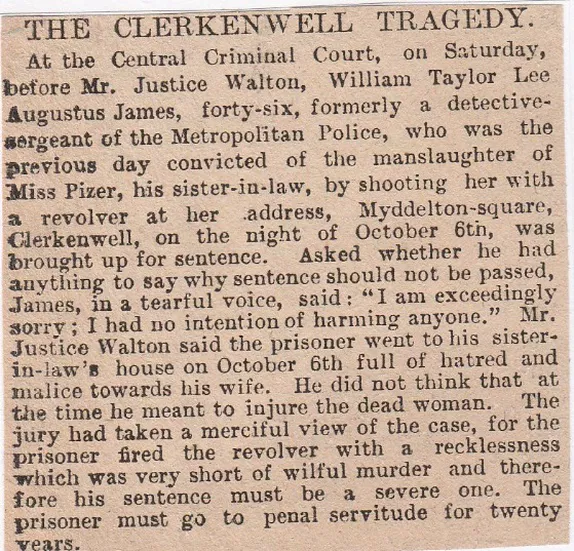
37/ Swain’s Lane Suicide, Highgate, April 1860
This was just down the road from The Flask and I used to go for walks down here when I had an hour or two off. But in 1860, a group of undertakers were coming back from Highgate Cemetery down Swain’s Lane, when they heard the sound of gunshots. They went to the direction of the reports and came across the body of a man lying in the road, with his head blown away. He had overloaded the pistol with gunpowder and placed it in his mouth, causing a mini explosion rather than firing a bullet. He had no identification upon him, but his shirt collar had “C.Crane No 10” marked on a tag and a card with an address in Chelsea on it. He had gunpowder, bullets, caps, a knife and razor, but not a penny in cash on him, so he clearly was determined to kill himself that day.
38/ Elmore Street (Human Foot Mystery), Islington, June 1869
A package wrapped in brown paper was found in a garden at Elmore Street in Islington, when opened up it was found to contain a human foot, which was enveloped in an Echo newspaper dated February 22nd. A letter was also inside, it read:
“Sunday-My Dearest Lizzie- I have sent the foot by Williams for your disposal; so be secret, as he knows nothing about the contents of the parcel. If you will bury it where we arranged, we shall, I hope, hear no more of it. If we can only get rid of the parts that I have here, it will be a good riddance. My conscience feels so heavy, and I feel so unhappy, that, were it not for your sake, I would, I think, confess everything. You know, were it not for that affair, it would not have happened. We have only one to fear. I need not mention names, as you know too well whom I mean. They say women cannot keep a secret, but I know from experience that that statement is false as far as you are concerned and that anything that would hurt me would never fall from your lips. Be sure and dispose of the contents of the parcel, as soon as you get it, and believe me, dearest lamb, yours sincerely- George”.
Police are investigating the matter and have found out the foot is that of a female.
39/ Charterhouse Square, August 1885 (Human Remains)
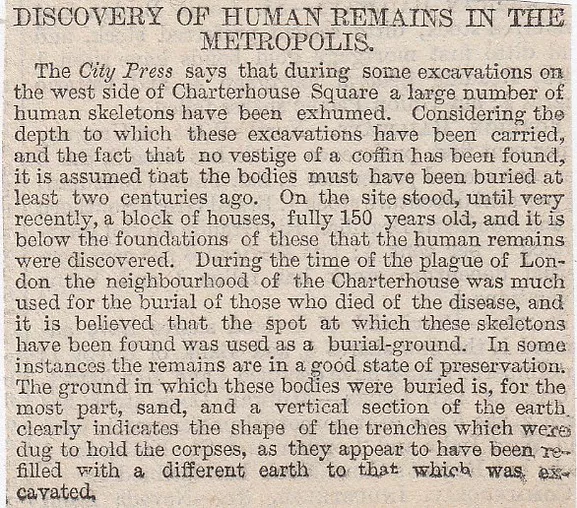
40/ New River Double Suicide, Highbury Vale, July 1860 (Lesbians or Best Friends Ever?)
I can’t work out if these two are really good friends or lesbian lovers! Anyway, Ann Page aged seventeen and her best friend in the whole wide world forever and ever, Miss Harding were, as you can gather, inseparable. So much so, that they attempted suicide together, with only Miss Page succeeding, by drowning themselves in the New River at Highbury Vale. Page was from St John Street Road and Miss Harding from Coppice Row and had met at Sunday School three years ago. One night Page had crept out at night to go out, causing her Dad to go looking for her. She came back in the morning when her mother struck her for being out all night at a Tailors Ball at Highbury Barn with another girl. Deceased then went to visit her friend and confidante and told Harding that she had sixpence on her and was going to buy some poison and this she had already mentioned to her mother. They both walked the streets of London for days, neither of them having any money until some kind bloke gave them some cash to buy food with. They lived on the money for a couple of days and then went to the deceased’s sister in Oxford Street to clean themselves up. Harding asked her if she was going to go home and she replied “I never will”, then asked her to commit suicide with her. Miss Harding agreed and they gripped each other’s arms and dived into the New River shouting “Oh, love! love!”.
The jury decided that Miss Page killed herself and Miss Harding would be charged with attempted suicide.
41/ Myddelton Passage, Clerkenwell, October 1897
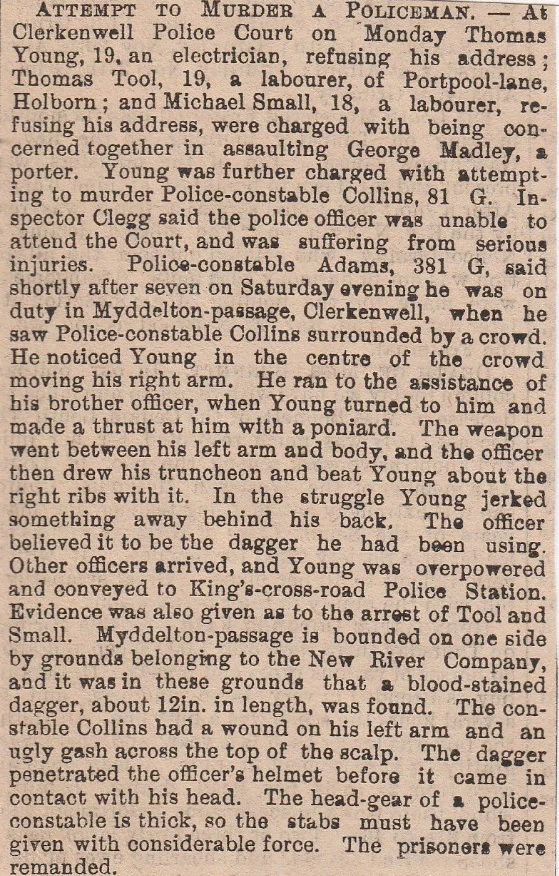
42/ Swan Public House Murder, (Lily Allen), Caledonian Road, Islington, March 1894
This pub is still there on Caledonian Road, now, I think, the Canal Bar and Restaurant (2016). This is the story of Lily Allen (not that one!) being murdered in the Swan pub in Islington. Lily was the step-daughter of the landlord, Mr F.Hill. One of the servants went up with a pot of tea and entered Lily’s room and found her lying on the floor with her throat cut, and the murderer also lying in another room with his throat slit from ear to ear. Another of the landlord’s daughters had tried to help her out during the stabbing and got stabbed herself. Turns out that Wards, the barman and murderer, rushed into the room and attacked them with a hatchet, then went at Miss Allen’s throat with a razor and then cut his throat when he saw what he had accomplished. Wards had a bit of a crush on Lily, who, the same as the 21st-century version, was a good-looking seventeen-year-old singer. Lily often had to turn away the young man’s advances, as he kept pestering her time after time, but that one night he lost it and went on his mad rampage, killing poor Lily Kate Allen.
43/ The Serpentine, Hyde Park, (Clerkenwell Man’s Death) October 1889
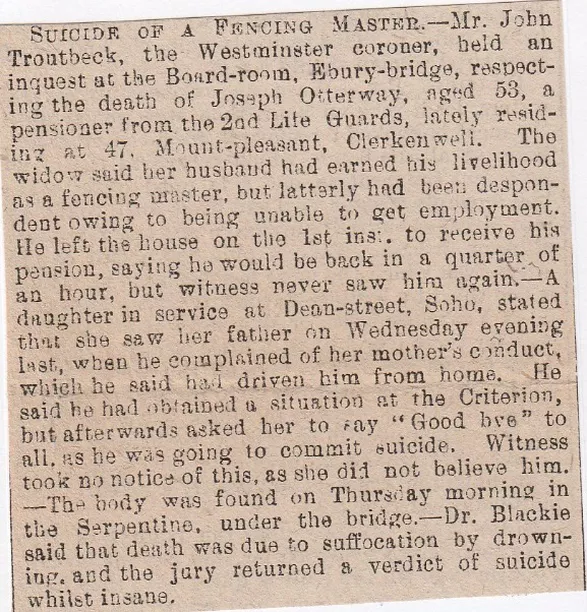
44/ Whitbreads Brewery Suicide, Chiswell Street, St Luke’s, November 1866
Thirty-year-old William Ward worked at the Whitbread brewery as a labourer, but one thing that other workmates noticed about him was his moody temperament. He had been suspended for a few days for swearing at a foreman, but when asked if he would calm down he said he would and was let back into work. He often asked his brother, with whom he lived at 20, Rose Street, St Luke’s, about the best way to kill himself but the brother thought he was kidding and so just laughed it off. One morning at the brewery, Daniel Freeman was working near vat number nineteen, which was full of carbonic acid gas, but no beer. Then he heard a match being struck so he shouted out for them to put it out, but got no reply. He ran to the top of the twenty-seven-foot high vat and found a light burning, with Ward at the bottom. He was completely lifeless, lying at the bottom of the vat. The body was dragged out, and the surgeon found his face contorted and his body swollen, killed by the gas and finally Ward had achieved his aim.
45/ Pentonville Road Suicide, July 1890
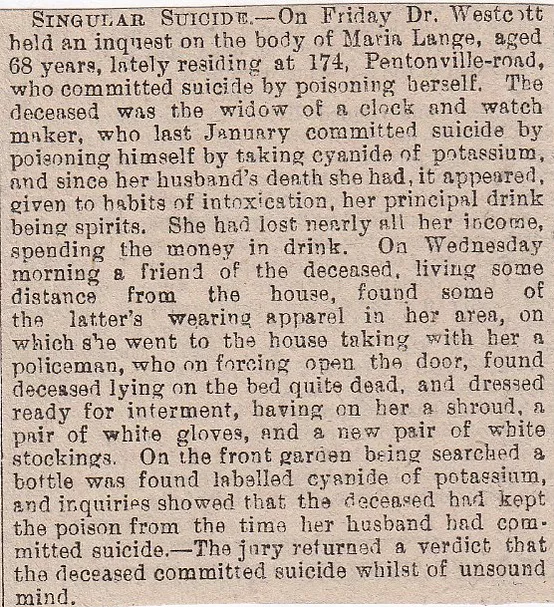
46/ Highbury Station Suicide, March 1888
An assistant school-master in Highbury by the name of Francis A.Silverlock, leapt from the platform at Highbury Station, straight onto the train tracks and in front of the Broad Street train. Both legs were severed off and he sustained severe head injuries. He died in Dalston Hospital that evening. A letter to his fiancee was found on him, and it read as follows:
“Dear Ida-I was asked to resign today. Now that means absolute ruin, and I am not prepared for that, and I am afraid I shall do a rash act. After all the years of slavery, I have done it all ends in being dismissed. What can I do without parchment, and with bad reports, how could I get employment anywhere? Now, dear, we have spent many happy years together, and without a cross word; it must not, therefore, be too much of an upset for you when you hear what I have done. Forgive me for causing you misery in leaving you, but I could not drag you along in the world with me in poverty. You know how I have tried, and how I have failed. My conscience is pretty clear that I have lived a pretty good life, and if God will pardon my rash act, I may get to Heaven. I almost feel inclined to desist when I think of you; but I think after a little while, you will think it is better as it is. Keep what I have given you, and do not think harshly of my act-Yours forever, though in the tomb-Frank”.
The second letter was addressed to his parents and it stated that he was given notice to leave, about what to do with the money he had saved up and what good parents they’ve been. It also mentioned the place of his suicide, so he’d planned it already.
47/ Wedmore Street Manslaughter?, September 1906
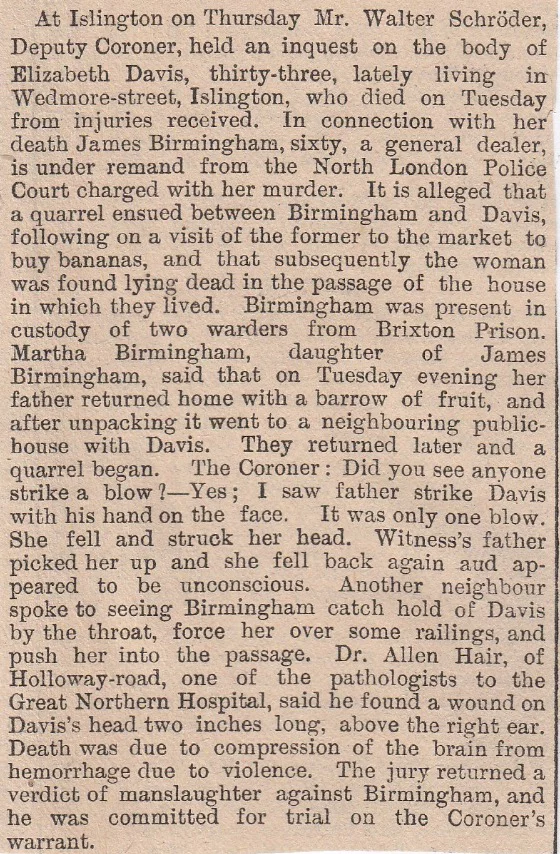
48/ Leather Lane, Clerkenwell, January 1885 (Fatal Sword Swallowing)
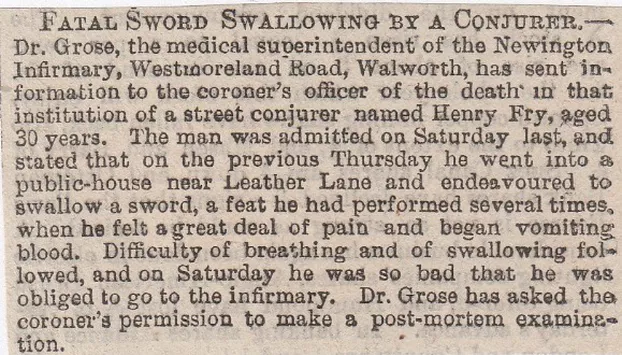
49/ Highbury Corner Omnibus Fatality July 1870
On Friday night a fatal accident happened to Mr J.T. Kershaw, of 90, St Paul’s Road, Canonbury, editor of a well-known handbook on the principle of rating. The deceased was riding on the box seat of a “Favourite” omnibus, and when within a few yards of Highbury corner, from some unexplained cause, he fell into the roadway, and one or two wheels passed over him. When lifted up he was quite dead. Mr Kershaw was a man of the most abstemious habits but was not able to insure his life owing to a bodily deformity. He has left a widow and eight children in dependent circumstances.
50/ Holloway Prison Fatality, September 1870
51/ Exmouth Street Fire, September 1870. (No 35 is near the Exmouth Arms pub)
52/ Islington Man Bled to Death, November 1870
53/ Forger Kills Himself (On way to Pentonville Prison) December 1902
54/ Death of a Fireman, Rosebery Avenue. September 1903
55/ Ex-Detective Murders Sister-in-Law, Clerkenwell. October 15th, 1903. (William Taylor Lee Augustus James)
Saturday, November 25th, 1903. Manslaughter by Ex-Detective.
At the Old Bailey, on Saturday, William Taylor Lee Augustus James, aged forty-six, formerly a detective-sergeant of the Metropolitan Police, who was on Friday found guilty of the manslaughter of Miss Pizer, his sister-in-law, by shooting her with a revolver at Clerkenwell, was brought up for sentence. Mr Justice Walton said prisoner went to the deceased’s house full of hatred and malice towards his wife. He did not think that at the time he meant to injure Miss Pizer. The jury has taken a merciful view of the case, for the prisoner fired the revolver with such recklessness that his crime was very little short of wilful murder. The prisoner was sentenced to twenty years’ penal servitude.
56/ Murder of a Son, Willow Street, Finsbury. October 22nd, 1903.
57/ City Road Child Murder, Islington. January 4th, 1904.
Saturday, January 9th, 1904. Child Murder in Islington.
At Worship Street, Adolph Diempich, aged thirty-five, journeyman butcher, was charged on remand with the wilful murder of his son Walter, aged eight months, by cutting his throat with a butcher’s knife, at 295, City Road, on the night of December 31st, 1903. Mr Frayling, from the Office of the Public Prosecutor, now conducted the case for the Treasury. Mr Crocker, solicitor, appeared for the prisoner.
58/ Murder in St Mary’s Workhouse Infirmary, Islington. February 1905
59/ Tramcar Death in Upper Street, Islington. December 1906
60/ Germans’ Sad Suicide Letters, April 1906. (Lodgings at Canonbury Square)
61/ City Banker’s Suicide in Old Street Railway Tunnel, 23rd October 1906.
The body of a gentleman in a mutilated condition was found in the Old Street tunnel on the City and South London Railway on Saturday and was yesterday identified as that of Mr P.Macfadyen, the head of the firm of P.Macfadyen and Co, agents and bankers, Winchester House, Old Broad Street, E.C. On Saturday a notice was posted at the office that the firm was compelled to stop payment.
Wednesday, 24th October 1906.
62/ Fatal Tramcar Accident in Archway Road, Highgate. October 1906
63/ School Mistress’s Suicide Note, Islington. August 1907.
64/ Rich Pauper Dies in Prison, April 1907.
The old man, Joseph Stourton, who lived for some time in Fulham Workhouse, concealing the fact that he was in receipt of a weekly allowance from a life interest in Consols, has died in Pentonville Prison hospital. At the inquest, it was said that when the Guardians on learning the true facts of the case, prosecuted Stourton for obtaining relief by false pretences, he was sentenced at West London, for three months imprisonment. After his release on Saturday week he was found intoxicated, and in default of paying a fine, went to gaol again for a week. He became delirious, and died from ulcerations and Bright’s Disease, accelerated by chronic alcoholism.
65/ Emaciated Man Dies in Workhouse Infirmary. December 1880
66/ Suicide at Frankfort House Coffee Tavern, Goswell Road. December 1880
67/ Old Woman Starves to Death, Spencer Street, Canonbury. December 1880
68/ Tailor Burned to Death. November 1880
Mr Langham held an inquiry at St Batholomew’s Hospital as to the death of Thomas New, sixty-eight, a tailor, living at 54, Bath Street, City Road. On Saturday night he and his daughter were engaged in cutting out some clothes. The daughter left the room for a short time, and during her absence, the deceased was heard to call for help. When she returned she found the room on fire, the deceased lying on the floor enveloped in flames, and a paraffin lamp, which had been hanging in the room, in the fireplace. He was removed to hospital, where he died the next day from the severe burns he received. “Accidental death ” was recorded.

